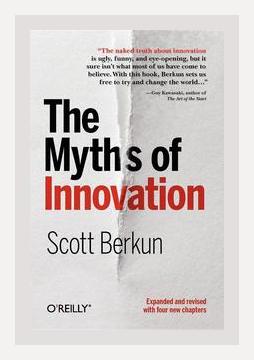Innovation and CreativityLeadership and ManagementDisruptive InnovationInnovation Leadership
Title: The Myths of Innovation
Author: Scott Berkun
Categories: Innovation Leadership, Disruptive Innovation
Summary of Major Points and Specific Actions
1. The Myth of Epiphany
Major Point: Innovation is often romanticized as the result of a sudden moment of insight or epiphany. However, Berkun argues that groundbreaking ideas rarely come from Aha! moments. Instead, they are usually the result of prolonged effort, experimentation, and iterative development.
Example: Berkun dismantles the myth by recounting Thomas Edison’s creation of the lightbulb. Edison and his team conducted thousands of experiments before arriving at a successful design.
Action: Break down your innovation process into iterative steps. Embrace trial and error and persistent effort instead of waiting for a sudden inspiration.
2. We Understand the History of Innovation
Major Point: The conventional history of innovation is often simplified and inaccurate. The breakthroughs we attribute to solitary geniuses are, in fact, the result of cumulative advancements and group efforts.
Example: Berkun revisits the story of the invention of the telephone. Both Alexander Graham Bell and Elisha Gray developed similar technology at almost the same time.
Action: Study the collective efforts and incremental improvements in your field. Collaborate with peers and share knowledge to accelerate innovation collectively.
3. There is a Method for Innovation
Major Point: Contrary to popular belief, there is no foolproof method or formula for innovation. While frameworks and methodologies can help, they cannot guarantee success.
Example: The rise of Google AdSense, which came from experimenting with various ideas and learning from failures, illustrates that flexibility is crucial.
Action: Adopt a flexible mindset and be willing to pivot or adapt your approach. Use frameworks as guides, not as rigid procedures.
4. People Love New Ideas
Major Point: While society celebrates innovation, individuals and organizations often resist change. New ideas frequently face significant resistance due to fear, uncertainty, and vested interests.
Example: The early backlash against the telephone, which critics claimed would invade privacy and disrupt social norms, shows the resistance to technological advancement.
Action: Prepare for and manage resistance by engaging stakeholders early, educating them about the benefits, and addressing their concerns.
5. The Lone Inventor
Major Point: The image of the lone, driven inventor is misleading. Most innovations result from teamwork and collaborative environments.
Example: The development of the airplane by the Wright brothers was a team effort, involving both brothers’ complementary skills in mechanics and engineering.
Action: Foster a collaborative culture and build diverse teams. Encourage cross-disciplinary collaboration to merge different perspectives and expertise.
6. Good Ideas Are Hard to Find
Major Point: Good ideas are often labeled as such only in hindsight. Initially, they might appear impractical or insignificant.
Example: The concept of the graphical user interface (GUI) was dismissed by some early computer scientists, yet it became a cornerstone of modern computing.
Action: Nurture potentially good ideas by giving them time and resources to develop. Maintain an open-minded approach and avoid dismissive judgments early on.
7. Your Boss Knows More About Innovation Than You
Major Point: Organizational hierarchies can stifle innovation. Often, the best ideas come from the grassroots level or from unexpected places within a company.
Example: The creation of 3M’s Post-it Note, which was invented by a scientist in the company’s research lab and not by executives, illustrates this point.
Action: Encourage bottom-up innovation by empowering employees at all levels to contribute ideas. Create channels for feedback and idea sharing across departments.
8. The Best Ideas Win
Major Point: The merit of an idea alone does not guarantee its success. Ideas require effective execution, marketing, and timing to thrive.
Example: Berkun cites the failure of the Betamax video format, which was technologically superior to VHS but lost the market due to less effective marketing and support.
Action: Focus on the holistic picture by pairing strong ideas with strategic execution, robust marketing, and understanding market dynamics.
9. Problems and Solutions in Innovation
Major Point: Innovations often begin with the identification of a problem rather than the search for a solution.
Example: The creation of the polio vaccine started with the urgent need to address the polio epidemic rather than a preconceived idea for a cure.
Action: Prioritize identifying and understanding problems within your domain. Conduct thorough needs assessments to ensure innovations are addressing real and relevant issues.
10. Innovation is Always Good
Major Point: Not all innovations lead to positive outcomes. They can have unintended or negative consequences that need careful consideration.
Example: Berkun mentions the advent of the automobile, which revolutionized transportation but also led to pollution and environmental challenges.
Action: Evaluate the potential impacts of your innovations, considering ethical, social, and environmental aspects. Promote sustainable and responsible innovation practices.
Conclusion: Navigating the Myths of Innovation
Scott Berkun’s “The Myths of Innovation” sheds light on the pervasive misconceptions surrounding the innovation process. By debunking these myths, Berkun encourages a more realistic and practical approach to innovation. Adopting his insights fosters an environment where creativity and sustained effort lead to meaningful advancements. The book serves as a guide for individuals and organizations aiming to harness the true essence of innovative thinking.
Action Recap:
– Embrace an iterative approach and persistent effort.
– Study collective and incremental advancements.
– Maintain flexibility in innovation methodologies.
– Manage resistance to new ideas with stakeholder engagement.
– Foster a collaborative culture within teams.
– Nurture ideas by giving them time to develop.
– Empower all levels of the organization to drive innovation.
– Couple strong ideas with effective execution and marketing.
– Focus on identifying and solving real problems.
– Evaluate innovations for ethical and social impacts.
These concrete actions align with the book’s principles and help in developing a robust innovation strategy.
Innovation and CreativityLeadership and ManagementDisruptive InnovationInnovation Leadership
